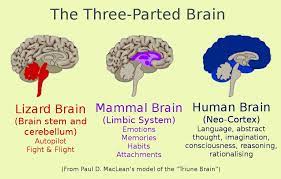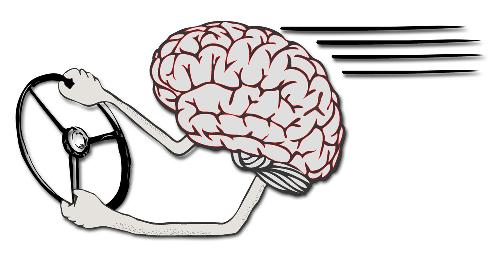Understanding Brain
May 12, 22Understanding Brain
Using MacLean's triune brain model to explain what I mean, we can take a cross-section of any human brain and see its evolutionary heritage. (I am aware that this model has been revised and fine-tuned, but it perfectly serves our purposes here because all we need to see here is that the brain has evolutionary regions that correspond to the same brain structures in different animals). MacLean divides the brain into three broad regions, the base of the brain is the reptilian brain that is analogous to the full brain of a repitle like a snake, lizard, bird, or alligator. We can observe reptiles to get a sense about what this core of the brain governs.

Reptiles have beating hearts. They eat when they are hungry. They procreate using sexual reproduction. They do not have language. They do not care for their young. The part of human beings that gets hungry and horny comes from the reptilian brain. But since it does not have language capacity, you cannot talk to the repilian brain.
The next layer is the limbic, or mammalian, brain. It adds the characteristics of the mammal to the mix. Mammals generally care for their young and mammals have some mix of emotional life. Dogs, for example, display an emotional life. They worry when their owners leave, and they show affection for their owners. In humans, this is the part of the brain that governs emotions like love or sadness or anger. The mammalian brain does not, however, have much in the way of a reasoning capacity. A dog never looks both ways before it crosses the road. Also, this part of the brain has very limited linguistic capacity. It can make some use of simple auditory linguistics.
Lastly, we have the neocortex, which is the part of the brain that is the center of higher reasoning. Decision making. Language use. Mathematics. Rational thinking. All of these are seated in the last-evolved neocortex.
Let's think about construction of the human brain as something analogous to the internal combustion engine. Once we had the core of the engine, the cylinders and the pistons that produce the engine's main work-generating capacity, aside from refinements, that core has remained pretty much the same since it's invention. Other innovations, such as hydraulic braking, power steering, air conditining, were grafted on top of that core. The brain's evolution likewise did not revise the basics that were covered by the reptile brain such as breathing or keeping a heart beating or a primal desire to procreate. Those things were already handled and handled well, so other functions like emotion and language processing were merely grafted on top of that basic structure.

Now, let's expand this analogy a bit and to our car add one of the latest innovations, the central computer. This, too, is grafted on top and it can use sensors to map the car's processes, such as air flow, gas mixture, and so forth, and now these are just running processes, thousands of them, running simultaneously, often with complex relationships among each other. If one process isn't running well, that has an effect on another process, and so forth.
The problem of consciousness is just that we don't understand it, but here we don't really need to understand it. All we need to understand here according to this model is that consciousness is just one process among the thousands of others and that it has a complex relationship to the others. So, if I do a ctrl-alt-delete on Windows PC and launch the services manager, I can see all of the processes running on that PC and how much of the system's resources those processes are using. If we could do that on our brains, using this model, we can imagine seeing a list of services that looks something like this:
- heartbeat.exe
- temperature.exe
- consciousness.exe
- sexdrive.exe
Interesting here is that while our consciousness is the part of us we elevate higher than all the others as that is the part of us that is self-aware, the part of us that we consider the ME, it is actually in this model only one process among thousands of others, and further, it doesn't have access, root or administrator privileges, to any of the other services.
The root user acts independently of consciousness, and it utilizes consciousness when it needs consciousness to do a conscious act. Otherwise, the heart keeps on beating and the temperature gets regulated and your horniness comes and it goes of its own accord. We delude ourselves, or consciousness maintains the idea, that consciousness is in control of the car, but in reality, the root user, which from henceforth I will merely call Brain, is in control.
To illustrate how Brain operates things, let's think about a fortuitious coincidence you experienced recently. Let's say that your school-aged son needed twenty dollars to purchase his yearbook and it was due tomorrow, and you were out of checks in your checkbook, and so you realized you needed to drive to the bank and get the money out of the ATM machine, but you were already in for the night and you didn't really want to get out. It is a bit chilly outside, so you decide you need to put on a jacket, so you go to he coat closet and you select a jacket that you haven't worn in quite some time, but it will suffice for this short trip to the bank. You put it on, you reach into the pocket, and you pull out a $20 bill. Hot damn! Can you believe the luck? I just happened to put on the jacket that I had forgotten about but had left a $20 bill in the pocket over a year ago. What a fortuitious coincidence!
So what happened here? That was not a fortuitous coincidence at all. Brain knew that money was in that coat pocket even though consciousness did not remember, and it was Brain that directed you to put on that coat. Probably something like 99% of the information being collected and filed by Brain never even reaches anyone's conscious awareness.
If Brain is the root user making all the decisions and is in control of the car, in what sense is anything anyone chooses or decides or believes in any sense within his or her rational control? For all intents and purposes, absolutely none. It is all Brain.
And so rhetoric, the art of persuasion, must target and communicate with Brain if it is to be effective at making Brain act in ways that we want it to act, or to believe things we want it to believe. We can call it persuasion if we like, but propaganda works, when it works, because it explicitly targets the underlying retilian and mammalian processes and cuts consciousness out of the equation as much as possible. Brain calls the shots, and Brain calls upon consciousness only when it is needed. So, what we must do with our rhetoric is use it to bypass consciousness and hit the parts of Brain that have no language, like the reptilian, or minimal and crude langauge, like the mammalian. We can do this by utilizing emotional backdoors, previous associations, and evolutionary hard-wiring to slide something into the hindbrain and do an end-run around consciousness.